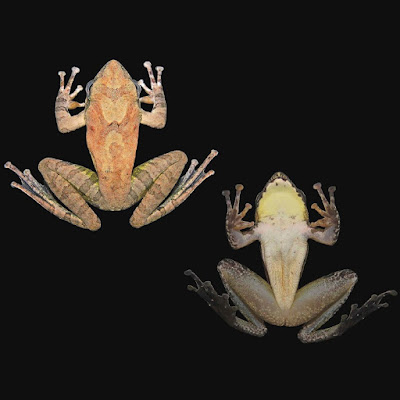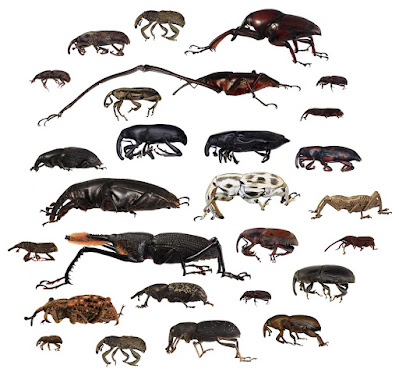[Most Recent Entries] [Calendar View]
Thursday, February 11th, 2021
| Time | Event | ||||
| 7:28a | [Herpetology • 2020] Buergeria choui • A New Species of Buergeria (Amphibia: Rhacophoridae) from the Southern Ryukyus and Northwestern Taiwan
Abstract Buergeria japonica, long thought to be a single species widely occurring on the Ryukyu Archipelago and Taiwan, proved to include three genetically differentiated clades, (1) the Northern and Central Ryukyu, (2) the Southern Ryukyu and Northern Taiwan, and (3) the Southern Taiwan clades. The Southern Taiwan clade has already been split from the others as a distinct species. A distinct heterospecific relationship of the Southern Ryukyu and Northern Taiwan clade from the Northern and Central Ryukyu clade was also clear from genetic evidence. Morphological comparison between specimens from the Yaeyama (the Southern Ryukyu and Northern Taiwan clade) and Amamioshima, the type locality of B. japonica (the Northern and Central Ryukyu clade), confirmed genetic differences and corroborate their independent species status. Thus, we describe the Northern Taiwan and Southern Ryukyu clade as Buergeria choui sp. nov. KEYWORDS: Buergeria choui sp. nov., mitochondrial DNA phylogeny, morphometry, Northern Taiwan, Southern Ryukyu
Buergeria choui sp. nov. [Japanese name: Yaeyama-Kajika-Gaeru] [English name: Yaeyama Kajika Frog] Polypedates japonicus: Van Denburgh, 1912, p. 205 (part); Okada, 1930, p. 192 (part); Okada, 1931, p. 207 (part); Okada, 1966, 178 (part). Rhacophorus japonicus Inger, 1947, p. 346 (part); Nakamura and Uéno, 1963, p. 67 (part). Buergeria japonica: Utsunomiya, 1979, p. 168 (part). Buergeria japonica Northern Taiwan +Southern Ryukyu (NT/SR) clade: Tominaga et al., 2015, p. 240. Buergeria japonica Japanese clade: Wang et al., 2017, p. 7. Diagnosis: The new species is placed in Buergeriinae Channing, 1989, with distal end of the third metacarpal scarcely flattened, lacking a bony knob. It is assigned to a member of the genus Buergeria by having small body, becoming slender posteriorly; dorsum yellow to gray brown, never changing to green; pupil horizontally ellipsoid; tympanum evident; vomerine teeth degenerated; webs well developed among toes, but absent among fingers; digital disks with circummarginal grooves; tips of distal digits T-shaped, not forked clearly; skin scattered with irregular tubercles without dorsolateral fold, but with supratympanic fold; ventral surface covered with rough circular tubercles; and a single vocal sac in males. Buergeria choui sp. nov. is very similar to B. japonica but is differentiated by morphometric characteristics and number and arrangements of dark spots on lower lips. It also is similar to B. sp. ST but differs in morphometric characteristics and markings on the thighs. Also, B. choui sp. nov., as well as B. japonica, lacks a long call unique to B. sp. ST. See Comparisons below for further details. Etymology: The specific name is dedicated to Dr. Wen-Hao Chou, Professor of the National Museum of Natural Science, Taichung, Taiwan, who first paid attention to the variation and taxonomy of B. japonica (sensu lato) at the beginning of 1990s. Masafumi Matsui and Atsushi Tominaga. 2020. A New Species of Buergeria from the Southern Ryukyus and Northwestern Taiwan (Amphibia: Rhacophoridae). Current Herpetology. 39(2); 160-172. DOI: 10.5358/hsj.39.160 | ||||
| 10:27a | [Entomology • 2021] First Phylogenetic Analysis of Dryophthorinae (Coleoptera, Curculionidae) based on Structural Alignment of Ribosomal DNA reveals Cenozoic Diversification
Abstract Dryophthorinae is an economically important, ecologically distinct, and ubiquitous monophyletic group of pantropical weevils with more than 1,200 species in 153 genera. This study provides the first comprehensive phylogeny of the group with the aim to provide insights into the process and timing of diversification of phytophagous insects, inform classification and facilitate predictions. The taxon sampling is the most extensive to date and includes representatives of all five dryophthorine tribes and all but one subtribe. The phylogeny is based on secondary structural alignment of 18S and 28S rRNA totaling 3,764 nucleotides analyzed under Bayesian and maximum likelihood inference. We used a fossil‐calibrated relaxed clock model with two approaches, node‐dating and fossilized birth‐death models, to estimate divergence times for the subfamily. All tribes except the species‐rich Rhynchophorini were found to be monophyletic, but higher support is required to ascertain the paraphyly of Rhynchophorini with more confidence. Nephius is closely related to Dryophthorini and Stromboscerini, and there is strong evidence for paraphyly of Sphenophorina. We find a large gap between the divergence of Dryophthorinae from their sister group Platypodinae in the Jurassic‐Cretaceous boundary and the diversification of extant species in the Cenozoic, highlighting the role of coevolution with angiosperms in this group. Keywords: angiosperms, coevolution, fossilized, birth‐death model, node dating, palm weevils, red palm weevil, structural alignment Maria Lourdes Chamorro, Bruno A. S. de Medeiros and Brian D. Farrell. 2021. First Phylogenetic Analysis of Dryophthorinae (Coleoptera, Curculionidae) based on Structural Alignment of Ribosomal DNA reveals Cenozoic Diversification. Ecology and Evolution. DOI: 10.1002/ece3.7131 |
| << Previous Day |
2021/02/11 [Calendar] |
Next Day >> |




